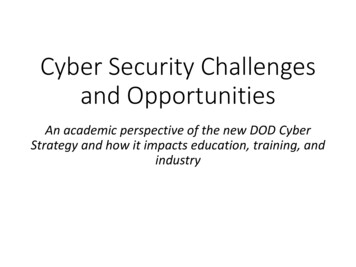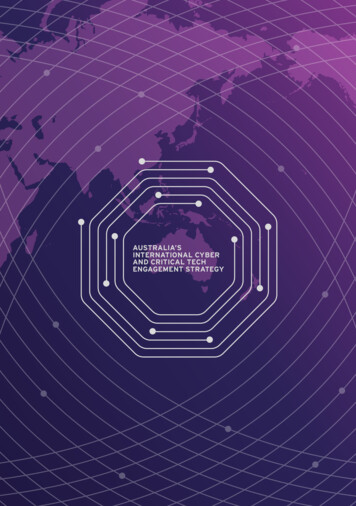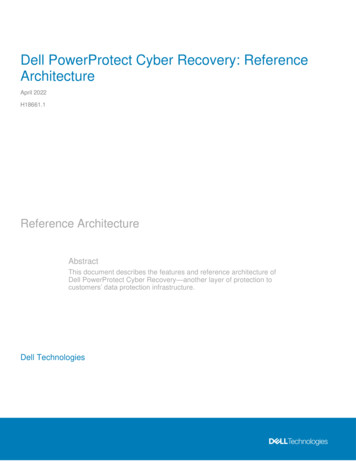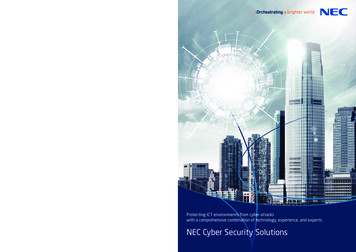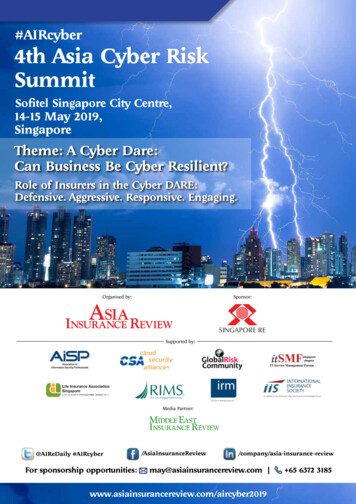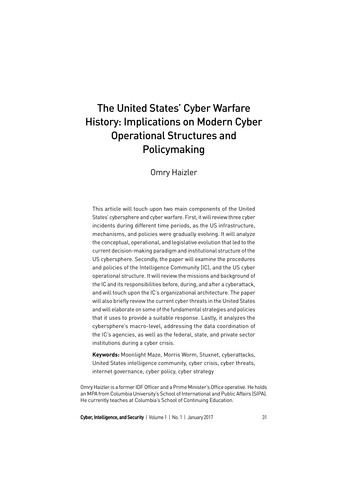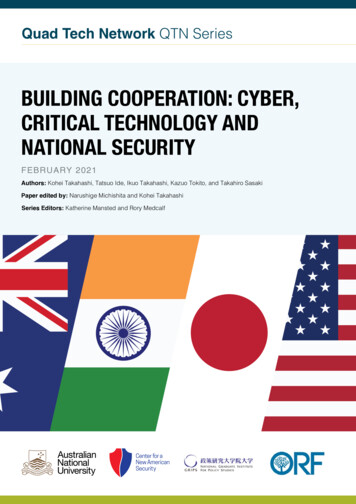
Transcription
Quad Tech Network QTN SeriesBUILDING COOPERATION: CYBER,CRITICAL TECHNOLOGY ANDNATIONAL SECURITYFEBRUARY 2021Authors: Kohei Takahashi, Tatsuo Ide, Ikuo Takahashi, Kazuo Tokito, and Takahiro SasakiPaper edited by: Narushige Michishita and Kohei TakahashiSeries Editors: Katherine Mansted and Rory MedcalfI
About the Quad Tech Network SeriesThe Quad Tech Network (QTN) is an Australian Government initiative to promote regional Track 2 research and public dialogue oncyber and critical technology issues.This paper is part of a series of papers by universities and think tanks in Australia (the National Security College at The AustralianNational University), India (the Observer Research Foundation), Japan (the National Graduate Institute for Policy Studies) and theUnited States (Center for a New American Security).The QTN series offers analysis and recommendations on shared challenges facing Australia and Indo-Pacific partners across fourthemes: international peace and security connectivity and regional resilience human rights and ethics, and national security.The QTN is managed by the National Security College at The Australian National University, with the support of the Australian Department of Foreign Affairs and Trade.About the Series EditorsRory Medcalf is Head of the National Security College at The Australian National University. Professor Medcalf’s professionalbackground spans diplomacy, journalism, think thanks and intelligence analysis, including as founding Director of the International Security Program at the Lowy Institute from 2007 to 2015. Professor Medcalf has been recognised as a thought leader internationally for his work on the Indo-Pacific concept of the Asian strategic environment, as articulated in his 2020 book Contest for theIndo-Pacific (released internationally as Indo-Pacific Empire).Katherine Mansted is the Senior Adviser for Public Policy at the National Security College at The Australian National University,and a non-resident fellow at the Alliance for Securing Democracy at the German Marshall Fund of the United States. She regularlywrites and presents to government and public audiences on technology and security policy. Ms Mansted holds a Master in PublicPolicy from the Harvard Kennedy School of Government, and a first-class degree in law and international relations.About The National Graduate Institute for Policy StudiesLocated in the heart of the fascinating city of Tokyo, the National Graduate Institute for Policy Studies (GRIPS) is an internationalpremier policy school with the aim of contributing to the betterment of democratic governance around the world. We excel at providing interdisciplinary education for future leaders in the public sector and conduct research on contemporary policy issues togenerate innovative solutions. Founded in 1997 as a stand-alone graduate institute, GRIPS comprises world-class academics anddistinguished practitioners with expertise in public sector policy formulation and management. Around 20 percent of the faculty and70 percent of students are recruited from outside Japan. Our vibrant, diverse student body consists of almost 400 members hailingfrom 63 countries and regions – all with the ambition to advance good governance across the globe or contribute to policy relatedresearch. We offer a diverse array of masters and doctoral programs, from which students cultivate the ability to analyze issues andsuggest solutions, develop interdisciplinary knowledge and skills that span related fields, and gain practical expertise. In addition toour degree programs, we also offer executive-level short-term training programs across a wide range of themes. Since our inception,our achievements in promoting good governance are considerable and far-reaching. Today, our impressive Alumni network of over4,000 strong are actively shaping policy in more than 100 countries around the world.For more information, please visit https://www.grips.ac.jp/en/Copyright 2021 National Graduate Institute for Policy StudiesPublished by the National Security College, The Australian National University, Acton ACT 2601, AustraliaAvailable to download for free at nsc.crawford.anu.edu.auCover design and layout by Black Bear Creative.II
About the AuthorsNarushige Michishita is vice president and professor at the National Graduate Institute for Policy Studies (GRIPS) in Tokyo.He has served as member of the National Security Secretariat Advisory Board of the Government of Japan, global fellow at theWoodrow Wilson International Center for Scholars in Washington DC, senior research fellow at Japan’s National Institute for Defense Studies, Ministry of Defense, and assistant counsellor at the Cabinet Secretariat for Security and Crisis Management of theGovernment of Japan. He acquired his Ph.D. with distinction from the School of Advanced International Studies (SAIS), JohnsHopkins University. A specialist in Japanese security and foreign policy as well as security issues on the Korean Peninsula, heis the author of “The US Maritime Strategy in the Pacific during the Cold War,” in Sebastian Bruns and Sarandis Papadopoulos,eds., Conceptualizing Maritime and Naval Strategy: Festschrift for Peter M. Swartz, Captain (USN) retired (Baden-Baden: Nomos,2020); Lessons of the Cold War in the Pacific: U.S. Maritime Strategy, Crisis Prevention, and Japan’s Role (Woodrow Wilson Center, 2016) (co-authored with Peter M. Swartz and David F. Winkler); and North Korea’s Military-Diplomatic Campaigns, 1966–2008(Routledge, 2009).Kohei Takahashi is a researcher at the National Graduate Institute for Policy Studies at GRIPS. He holds a Ph.D. in sociologyfrom the University of California, Riverside. He is a member of Center of Innovation, one of the main funding programs under theCenter of Innovation Science and Technology–based Radical Innovation and Entrepreneurship Program launched by the Ministryof Education, Culture, Sports, Science and Technology in 2013.Tatsuo Ide is Commander of the Japan Maritime Self-Defense Force and visiting researcher at GRIPS, Meiji University, and Waseda University. He holds a bachelor’s degree in aerospace engineering from the National Defense Academy of Japan, a master’sdegree in nature and environment from the University of Air, and a doctorate from the Graduate School of Global Information andTelecommunication Studies, Waseda University. He has served as a line officer aboard JS Yamagiri, JS Okishio, and JS Harushio,a military system engineer in the Program Center, Command and Control System Center, and Ship System Center, and a staff inthe Maritime Staff Office and the Joint Staff Office.Takahiro Sasaki is Rear Admiral (retired) of the Japan Maritime Self-Defense Force (JMSDF), Research Principal at the National Security Institute of the Fujitsu Systems Integration Laboratories, visiting professor at the Hiroshima University and the TokaiUniversity, and visiting researcher at the Meiji University. He holds a bachelor’s degree in electrical engineering from the NationalDefense Academy, graduated from the Royal Australian Naval Staff College, and received a Graduate Certificate in Management from the Queensland University of Technology. He also finished the International Intelligence Directors Course at the BritishIntelligence School, and received a master’s degree in international relations from the Nihon University. During the service in theJMSDF, he commanded destroyer JS Yuubetsu, and four other destroyers including Aegis-equipped destroyer JS Kirishima ofthe Escort Division Eight. He also served as defense attaché in Russia and as the First Cybersecurity Coordinator in the Joint StaffOffice. He is a specialist of Russia’s national security and military policy as well as cyber and information warfare.Ikuo Takahashi is a lawyer and the president of IT Research Art. He is also a founder of the Komazawa Legal Chambers (DaiichiTokyo Bar Association). He received an Information Security Culture Award hosted by the Institute of Information Security in 2012.He has co-authored “Digital Evidence Legal Practice Q&A,” “Virtual Currency,” and “IT security Café.”Kazuo Tokito is Major General (retired) of the Japan Air Self-Defense Force (JASDF), an advisor at the Defense Systems Group ofHitachi Ltd., and visiting fellow at the Japan Air Self-Defense Force Command and Staff College. He graduated from the NationalDefense Academy, majoring in electrical engineering. He also graduated from the JASDF Officer Candidate School. He acquireda master’s degree in computer science at the National Defense Academy, and a doctorate in engineering from the Shinshu University. As for the service career, he worked at several radar sites and JASDF’s Sector Operation Centers as a communicationsand systems officer. He worked as a chief of C4 systems division (A6) at the Air Staff Office, and as a commanding officer ofPatriot Missile Group and Air Wing. His significant careers were Director of C4 and cyber (J6) at the Joint Staff Office and a basecommander of the Matsushima Air Base. He retired from JASDF as a vice commander of the Northern Air Defense Command.III
Cyber Security, Critical Technology, and National SecurityContentsEXECUTIVE SUMMARY1A STUDY OF CRITICAL TECHNOLOGY IN THE FIELD OF DEFENSE3Definitions of Critical Technology3Critical Technologies in Japan4Similarities and Differences5Conclusion5CYBER AND CRITICAL TECHNOLOGIES: LAW AND POLICY IN JAPANCyber Laws and Policies6Enabling and Protecting Cyber and Critical Technologies7Prospects for International Cooperation in Cyber Security8DETERRENCE AND ARMS RACES IN CYBER SPACE10Deterrence10Characteristics and Problems of Deterrence in the Cyber Domain10From Single Domain to All Domain11Applying Deterrence Theory in Practice: Two Examples12An Arms Race for Cyber Deterrence12Trends of the Japan–Australia Cyber Cooperation13CHINESE CYBER WARFARE AND JAPAN’S RESPONSE15Chinese Cyber Attacks against Japan15Trends in Chinese Cyber Attacks16Future Trajectory of Cyber Warfare by China16Japan’s Response17Recommendations for Quad Cooperation19CONCLUSION21Suggestions on the QTN21Suggestions on Critical Technology22ENDNOTESIV623
Quad Tech Network QTN SeriesExecutive SummaryThe novel coronavirus pandemic has illustrated the significant roleof states in enacting effective multilateral responses toward thepandemic, which has transformed the relationship between individuals and states. However, the pandemic has also revealed thevulnerability of international governmental and non-governmentalorganizations, where the United Nations appears to be somewhatuninvolved. The World Health Organization (WHO) is supposedto play a central role in response to the pandemic. Instead, thepandemic has escalated geopolitical tensions that consequentlyreoriented geopolitics. Moreover, distrust and suspicions havebeen simmering among rival states – for example, the tensionbetween the United States and China that unfolded at the annualUN General Assembly in New York on September 22, 2020. TheUS President Donald Trump argued that China was responsiblefor the pandemic as he called it the “China virus.” Trump asserted:“as we pursue this bright future, we must hold accountable thenation which unleashed this plague onto the world: China TheChinese government and the World Health Organization – whichis virtually controlled by China – falsely declared that there was noevidence of human-to-human transmission. Later, they falsely saidthat people without symptoms would not spread the disease.”1 Inresponse, China denounced the US global campaign to rally otherstates against China. In addition, Chinese President Xi Jinpingargued that “we should enhance solidarity and get this throughtogether Any attempt of politicizing the issue or stigmatizationmust be rejected.”2Several rivals are taking advantage of the pandemic to advance“gray-zone” strategies, such as economic coercion, cyber operations, and low-intensity violence.3 The United States SpecialOperations Command defines the gray zone as “competitive interactions among and within state and non-state actors that fallbetween the traditional war and peace duality.”4 In other words,invisible threats are characterized as gray-zone conflicts, where theboundaries between peace and war become increasingly blurred.In this context, the Chinese government economically pressuredAustralia to soften the nation’s policy against China when Australia called for an independent inquiry into the origin of COVID-19.The Chinese government suspended meat imports from Australian suppliers and issued a travel warning for its citizens againstAustralia.5 Accordingly, the United States has expanded what itconsiders to be matters of national security, which now includesmedical supplies, surgical face masks, and other items essentialfor handling of the pandemic. However, Chinese corporationsdominate the market of these products and have become integral parts of US supply chains. Bill Greenwalt, a senior fellow atthe Atlantic Council and a former Pentagon official, argues that“these are now national security needs and we probably shouldhave been thinking about it a long time ago in terms of biowarfarethat we should have a trusted industrial base or a set of trustedcontributed by Kohei Takahashi.allies – the UK, or NATO allies or Japan or Korea.”6 Therefore,the pandemic reveals the risk of China-centered supply chains.Cyber attacks, which are one of the gray-zone methods, havebecome widespread during the pandemic. Australian Prime Minister Scott Morrison revealed that the government and institutionswere being targeted in a “sophisticated state-based” cyber attack.7 Although the prime minister refused to disclose the identityof the state, it is widely believed that China was responsible forthe cyber attack. Similarly, India has confronted an increasednumber of cyber attacks from both China and Pakistan. Attacksfrom China surged dramatically in March 2020, mainly targetinghealth care and educational institutions during the pandemic.8Thus, similarly inclined democratic states should cooperate andcoordinate effective multilateral responses against such grayzone tactics. Primarily, experts from academia and think tanksshould be able to discuss such issues among their counterpartsfrom allied democratic states in a forum where all participantsrespect the principles of transparency and freedom of expression.The Quad Tech Network (QTN) has the potential to provide sucha platform. The QTN is also expected to promote engagementwith academic and think tank partners for research on cyberand critical technology issues that reflect Australia’s interestsas a liberal democracy committed to the international rulesbased order. The QTN should aim to be a platform where alliesand cooperative states can collectively respond to gray-zonewarfare. Consequently, it will be beneficial for the four memberdemocracies, including Australia. In this context, Japan is oneof the states that will play a vital role in this platform. Accordingly, this paper shares insights and experiences on this subjectfrom a Japanese perspective. This paper discusses key issuesin national security, cyber security, and critical technologies forJapan. It has four sections: (1) Critical Technology in the Fieldof Defense: A Comparison between NATO and Japan (2) Lawsand Policies for Cyber and Critical Technologies in Japan; (3)Deterrence and Arms Races in Cyber Space; and (4) ChineseCyber Warfare and Japan’s Response.The protection of critical technology, intellectual property, anddata from theft or acquisition by a rival state is imperative. In thefirst section, Dr. Tatsuo Ide uses documents on NATO and Japan’scritical technologies to clarify the critical technologies that will bevital for future defense. In addition, he compares the similaritiesand differences between the critical technologies approachesof Japan and other NATO countries. In the second section, Mr.Ikuo Takahashi further discusses cyber and critical technologiesfrom the perspective of Japan’s laws and policies. In addition,Dr. Takahashi describes Japan’s challenges in cooperating withallied democratic states in the field of cyber security and criticaltechnologies.1
Cyber Security, Critical Technology, and National SecurityAs mentioned above, cyber operations are significant in grayzone warfare. These operations include cyber-driven cognitiveattacks, such as dissemination of fake news. In the third section,Dr. Kazuo Tokito discusses deterrence and arms races in cyberspace with the help of examples (Russia and Japan). Moreover,Dr. Tokito discusses the indispensable role of critical technologiessuch as AI and quantum science in cyber operations. In the lastsection, Professor Takahiro Sasaki discusses China’s cyber war-fare and Japan’s response to it. Professor Sasaki takes up casesof cyber attacks against Japan in which China was supposedlyinvolved and analyzes their characteristics and trends. In addition, he focuses on the future direction of China’s cyber warfareand how AI will be used in such cyber warfare. Furthermore, heexamines Japan’s tactical responses to Chinese cyber threats.Finally, he proposes recommendations for the QTN in attenuatingcyber warfare and securing global cyber space.Common interests are autonomy, space, and hypersonics, and although there are differences, many of these technologies are expected to evolve in the future. Picture: Bill Ingalls / NASA, https://flic.kr/p/JtiLU72
Quad Tech Network QTN SeriesA Study of Critical Technology in the Field of Defensecontributed by Tatsuo Ide.Recently, every country has been making great effort to obtainnew technologies. The acquisition of, for example, revolutionaryspace or hypersonic technologies will bring competitive advantages to both business and defense.What is a critical technology? What technologies are attractingattention in the field of defense? How do countries’ definitions ofcritical technologies differ? This section will examine these pointsby comparing two published documents of NATO and Japan: “Science & Technology Trends 2020–2040,” which was published by NATO’s Science Technology Organization (STO)in March 2020, and covers the period 202-02040 “R&D Vision,” which was published by Japan’s Acquisition,Technology & Logistics Agency (ATLA), an auxiliary agency (external bureau) of the Ministry of Defense of Japan, inAugust 2019, and covers the period 2019–2038.Although there are differences between an international organization and a national organization, the documents are suitablefor comparing the views of Europe, the United States, and Japanin view of the universality of science and technology.Definitions of Critical TechnologyThere are many similarities between the “Science & TechnologyTrends 2020–2040” and the “R&D Vision”. The former was published by STO, which is an auxiliary body of NATO, while the latterwas published by ATLA, which is an auxiliary agency (externalbureau) of the Ministry of Defense of Japan.9 The former waspublished in March 2020, and the latter was published aroundthe same time, in August 2019. The former covers the period2020–2040, and the latter 2019–2038.NATO identifies three categories of technologies that will have asignificant impact on future defense10:1.2.3.Emerging: Those technologies or scientific discoveries thatare expected to reach maturity in the period 2020–2040 andare not widely in use currently or whose effects on Alliancedefense, security, and enterprise functions are not entirelyclear.NATO’s Critical TechnologiesNATO’s “Science Technology & Trends 2020–2040” identifiesfour characteristics common to many defense technologies overthe next 20 years:1.Intelligent: Technologies that exploit integrated AI, knowledge-focused analytic capabilities, and symbiotic AI/humanintelligence to provide disruptive applications across thetechnological spectrum.2.Interconnected: Technologies that exploit the network ofvirtual and physical domains, including networks of sensors,organizations, individuals, and autonomous agents, linked vianew encryption methods and distributed ledger technologies.3.Distributed: Technologies that employ decentralized andubiquitous large-scale sensing, storage, and computationto achieve new disruptive military effects.4.Digital: Technologies that digitally blend the human, physical,and information domains to support novel disruptive effects.The NATO document recognizes eight closely related areas ascritical technologies for the next 20 years11:1.data2.artificial m7.biotechnology8.materials.In particular, the document points out the enormous impact ofthe following six synergistic effects:1.data–AI–autonomyDisruptive: Those technologies or scientific discoveriesthat are expected to have a major, or perhaps revolutionary,effect on NATO defense, security, or enterprise functions inthe period –material4.data–quantumConvergent: A combination of technologies that are combined in a novel manner to create a disruptive erial.These three are together called “emerging and disruptive technologies.” On the other hand, in Japan’s “R&D Vision,” innovativetechnologies are called “game-changers” without any particulardefinitions. Both are terms that mean bringing about completechanges in future defense – and so are defined here as “criticaltechnologies.”To keep pace with these science and technology trends, NATOmilitaries are working together with companies to expand theircapabilities, taking into account legal, policy, economic, andorganizational constraints.123
Cyber Security, Critical Technology, and National SecurityCritical Technologies in JapanWhile NATO documents are written without any particular framework, Japan’s “R&D Vision” describes three areas for strengtheningcapability acquisition in new areas necessary for cross-area operations, and two areas for strengthening capacity in conventionalareas, each of which will be implemented by 2038.Electromagnetic Spectrum TechnologiesAccording to “R&D Vision,” the electromagnetic spectrum (EMSdomain) is an important area related to wide-ranging defenseactivities such as Intelligence Surveillance and Reconnaissance(ISR,), information sharing, and precise guidance. It is necessaryto endeavour to achieve effective and efficient use of the EMS.Technologies that the Ministry of Defense (MoD) should acquireare as follows:13 Electronic attack technologies – including high-energy laser,high-power microwave, and jamming technologies. Electronic protection technologies – including Low Probabilityof Intercept/Detection (LPI/LPD) communication, anti-jamming,and electromagnetic pulse (EMP) protection technologies. Electronic warfare support technologies – including electronicintelligence (ELINT) technology. Electromagnetic spectrum technologies (EMS) – includingEMS domain awareness; and optimization of frequency allocation technologies.Cyber Defense TechnologiesAccording to “R&D Vision,” the stable use of cyber space isimperative for the Ministry of Defense (MoD) and Self-DefenseForces (SDF). It is necessary to advance research of the latesttechnology centered on operation continuity to support MoD/SDFactivities, while strengthening collaboration with relevant ministries and agencies. Technologies that the MoD should acquireare as follows15: Manual operation continuity measures. Automatic operation continuity measures – including cyberand mobile cyber resilience technologies. Preventative measures – including cyber countermeasurefor platform computer systems, anti-tamper, supply chainintegrity, anti-malware and firewall, and vulnerability inspection technologies. Disruption capabilities.Underwater Warfare TechnologiesAccording to “R&D Vision,” it is fundamental to develop multi-mission unmanned vehicles, as well as technology for unmannedand manned vehicles to collaborate organically as underwaterdefense systems, in order to drastically improve underwaterdefense capability and efficiency. Technologies that the MoDshould acquire are as follows16: Autonomy – including situational awareness and high-reliability technologies, and behavior decision technologies forunmanned underwater vehicles. ISR – including detection and underwater communicationtechnologies. Support technologies – including automatic docking; charge,supply, and maneuver technologies. Countermeasure technology – including signature reductiontechnology.Technologies for Persistent ISR including SpaceAccording to “R&D Vision,” in light of nearby countries’ activitiesand expansion of ISR targets and domains, there is a need torealize efficient and effective ISR based on improvement of sensors’ detecting capability and an increase of sensor platforms.Technologies that the MoD should acquire are as follows:14 Sensing and radar technologies – including over-the-horizonradar, advanced multi-static radar, ultra-long-range radar,and imaging radar technologies. Electro-optical and infrared sensors – including satellite-borne(EO/IR) sensors.4
Quad Tech Network QTN SeriesStand-off Defense TechnologiesAccording to “R&D Vision,” it is necessary to acquire a stand-offcapability out of an adversary’s effective range that can securepersonnel safety due to its high survivability, long range, andhypersonic velocity. Technologies that the MoD should acquireare as follows:17 Fire control – including satellite guidance technologies, andinfrared radar seekers compatible with hypersonic missiletechnology. Propulsion technologies – including scramjet engine, andhigh-performance rocket motor technologies. Airframe and warhead technologies – including advancedwarheads for anti-surface missiles, aerodynamic airframedesign for gliding projectiles at high altitude, and glidingflight control aerodynamic design technologies.Table 1: Common areas in critical technologies“Science &TechnologyTrends 2020–2040” (NATO)AutonomySpaceWhile NATO’s documents describe emerging and disruptivetechnologies, Japan’s documents describe in detail technologies that are required in connection with future operational anddefense needs. In other words, NATO uses a technology-basedapproach, whereas Japan uses an operational-based approach.In preparing for the future, there is a need to involve a wide rangeof stakeholders, including technology experts and companies,and to position them in a policy approach, but Japan’s approachis to position them in operations.19 However, the game-changerthat Japan is looking for is not a needs-based one, but a seedsbased one, and the seeds-based approach like that of NATO islikely to be suitable. NATO and Japan will be able to find commoninterests in the fields of autonomy, space, and hypersonics, whereresearch cooperation may also be possible. Situational awareness technology High-reliability technology Behavior decision technology forunmanned underwater vehiclesEO/IR sensorSatellite-borne EO/IR sensor technologyFire control HypersonicsComparing the critical technologies of interest between the two,the following commonalities were revealed. It should be notedthat the granularity of the items is finer in Japan, so to facilitate thecomparison only the large items in Japan were covered. Table 1summarizes the common areas.Differences in NATO, where there is no equivalent in Japan,were data, artificial intelligence, quantum, biotechnology, andmaterials. Also in Japan, areas where there is no equivalent inNATO were electronic spectrum (EMS) technologies and cyberdefense technologies. These technologies are expected to beused universally in society in the future.18 Although they are notcentral issues, they will be used in both countries.Autonomy Similarities and DifferencesWhile NATO’s “Science & Technology Trends” document focuseson elemental technologies, Japan’s R&D strategy is centered ondeveloping and applied technologies.“R&D Vision” (Japan)Midcourse guidance via satellitestechnologyPropulsion Scramjet engine technology High-performance rocket motortechnologyAirframe and warhead Aerodynamic airframe design ofgliding projectile at high-altitudetechnology Gliding flight control aerodynamicdesign technologyConclusionJapan’s “R&D Vision” mainly describes operations in five fields,while NATO’s “Science & Technology Trends 2020–2040” describesmainly the technologies without setting a particular framework.Common interests are autonomy, space, and hypersonics, andalthough there are differences, many of these technologies areexpected to evolve in the future, and the differences are simplythose of perspective.In summary, NATO focuses on seeds, and Japan considersoperations as needs, and each approach has its ownadvantages. However, if Japan is looking for a gamechanger, the seeds-based approach that comes fromexamining technology, rather than the needs-basedapproach that comes from operations, is more flexibleand purpose-based.5
Cyber Security, Critical Technology, and National SecurityCyber and Critical Technologies: Law and Policy in Japancontributed by Ikuo Takahashi.Cyber Laws and PoliciesIn 2000, the “Basic Act on the Formation of an Advanced Information and Telecommunications Network Society” (the “IT BasicLaw”) was enacted, encouraging society to use the internet. InJanuary 2001, the Strategic Headquarters for the Promotion of anAdvanced Information and Telecommunications Network Societywas established in the Cabinet to formulate specific strategies.20Then, a new IT strategy was announced in 2019. In addition, anew IT strategy for 2020 has been announced that incorporatesmany perspectives on changes in society and values and issuesbrought about by the coronavirus pandemic and responses to it.Regarding cyber security, the Cyber Security Basic Law formsthe basic legal framework.21 In January 2015, the Cyber SecurityStrategic Headquarters was established based on this framework,and the National Center of Incident Readiness
cyber security critical technology and national security iv contents a study of critical technology in the field of defense cyber and critical technologies: law and policy in japan deterrence and arms races in cyber space chinese cyber warfare and japan's response conclusion endnotes executive summary 3 6 10 15 21 23 1 6 10 15 21 12 17 3 7 10 .

